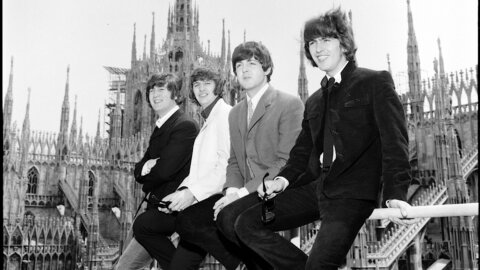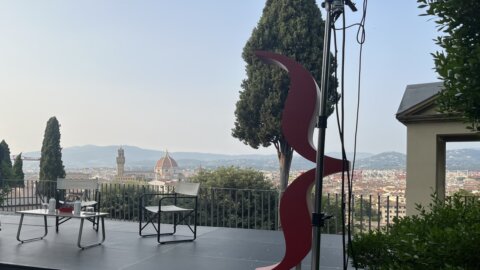Christie’s is honored to announce early highlights and international tour dates for the upcoming sales of property from the Clark Family Collection. As one of the nation’s wealthiest men at the turn of the 20th century, William Andrews (W.A.) Clark’s (1839-1925) name is synonymous with American aspiration, having built a successful personal empire in multiple industries, most notably copper mining. His vast wealth allowed him to pursue a lifelong passion for art and culture that he shared with his wife and daughters, who expanded the family collection over the decades. In total, over 400 items, including fine art, musical instruments, Gilded Age furnishings, decorative arts, and rare books collected by two generations of the Clark family will be offered for sale at Christie’s this spring, opening a new chapter in the story of one of the cornerstone dynasties of the Industrial Age in America.
Highlights of the collection will be shared with the public through a series of preview exhibitions around the globe in the coming weeks, beginning with an unveiling of the Impressionist and Modern works at Christie’s London that runs through February 4, 2014. The total collection is expected to realize in excess of $50 million.
THE ‘COPPER KING’ AND A LEGACY OF COLLECTING
From humble beginnings, W.A. Clark rose to national prominence, standing alongside men like John D. Rockefeller as one of the wealthiest men in the United States. Born in a log cabin in Pennsylvania in 1839, Clark moved to Iowa with his family in 1856, where he taught school and enrolled in law school. Like many men of his generation, Clark was struck by “gold fever,” traveling West in the hopes of striking it rich.
Throughout the mid-1800s, W.A. Clark’s business interests expanded and transformed with the needs of Western commerce. Clark married Katherine ‘Kate’ Stauffer, and moved his family east to study assaying and mineralogy in New York. He soon returned to the West, where Clark fostered a growing empire around the town of Butte, Montana. Dubbed the “Copper King,” Clark’s enterprises flourished, with ventures that included railroads, banking, publishing, sugar, and timber companies. He was responsible for spurring the development of a remote stop on his railroad line in Nevada, creating the city now known as Las Vegas in the heart of Clark County. His business interests eventually led him toward a career in politics, where he represented the state of Montana in the U.S. Senate from 1901 to 1907.
Fourteen years after his wife Kate’s death in 1893, Clark remarried in a secret ceremony in France. His second wife, Anna Eugenia La Chapelle (1878-1963), was a musician who excelled at the harp, and the couple went on to have two children: Louisa Amelia Andrée Clark (1902-1919; known as Andrée) and Huguette Marcelle Clark (1906-2011). The Clark girls experienced the privileged and cultured upbringing befitting the daughters of one of America’s wealthiest men, attending Miss Spence’s School for Girls among the children of New York’s social elite. Their home, a Beaux-Arts mansion on Fifth Avenue, was a marvel of Golden Age architecture, and was considered one of the grandest private residences in American history.
By the late 1870s, W.A. Clark had begun to amass one of the country’s greatest collections of fine and decorative art. Clark rarely sold or exchanged works, preferring to watch his collection grow. When he died in 1925, Clark left a vast fortune that was said to be equivalent to one day’s share of the United States’ gross national product at the time. A significant portion of his collection — over 200 works of art, including paintings, sculpture, tapestries, rugs, antiquities, and furniture — were gifted to the Corcoran Gallery of Art in Washington, D.C., with W.A. Clark’s heirs providing funds for the museum’s celebrated Clark Wing.
Andrée Clark died in 1919, just before her 17th birthday, leaving Huguette with her mother, Anna, upon W.A.’s death. Ms. Clark and her mother moved to 907 Fifth Avenue in Manhattan, where they maintained three apartments. Together, Anna and Huguette expanded the collection W.A. had started, appointing their properties at 907 Fifth Avenue in New York and at the Bellosguardo Estate in Santa Barbara, California with sumptuous French furnishings, Asian antiquities, European paintings and fine musical instruments.
Huguette inherited her parents’ love for fine art and music, and became an accomplished artist and musician in her own right. In 1929, the Corcoran Gallery hosted an exhibition of her paintings, which were well-received by critics. After her mother’s death in 1963, Huguette Clark lived quietly in New York, shunning the spotlight to focus on her art and collecting. She died in May 2011 at the age of 104, with a fortune estimated in the hundreds of millions and with no direct descendants. As part of the settlement of the Clark estate, the collection is being offered at auction by the Honorable Ethel J. Griffin, New York County’s Public Administrator, by the authority of the Surrogate’s Court of the State of New York, County of New York. The proceeds from the sales will go back to the Estate for distribution in accordance with the settlement agreement.
HIGHLIGHTS FROM THE UPCOMING SALES
IMPRESSIONIST & MODERN ART IMPRESSIONIST & MODERN EVENING SALE | 6 MAY 2014
CLAUDE MONET
Nymphéas | Estimate: $25,000,000-35,000,000
Huguette Clark purchased Claude Monet’s Nymphéas in 1930 in New York from the Durand-Ruel Galleries, whose Paris branch had jointly acquired the work with the Galerie Bernheim-Jeune directly from the artist ten years earlier. A splendid example of the artist’s pre-eminent theme – his beloved lily pond at Giverny – Clark’s Nymphéas was painted in 1907, during an intense creative period in Monet’s career. The artist had enjoyed a celebrated career in Paris as the leading artist of the Impressionist movement when he moved with his family to the small farming community of Giverny in 1883 and began working on the elaborate gardens that would inspire him for the last two decades of his life. Between 1905 and 1908, Monet worked feverishly to complete more than 60 increasingly abstract views of the pond, equivalent to about one every three weeks. The painting is distinguished by its strong color contrasts, aggressive brushwork, and novel vertical format. One contemporary critic enthused about the Nymphéas series, “There is no other living artist who could have given us these marvelous effects of light and shadow, this glorious feast of color.” Since entering the collection of Huguette Clark, the present Nymphéas has remained out of the public eye. The international tour in anticipation of the May auction will be the first time the painting is publicly exhibited since 1926.
PIERRE-AUGUSTE RENOIR
Jeunes filles jouant au volant | Estimate: $10,000,000-15,000,000
Renoir painted Jeunes filles jouant au volant circa 1887, after a three-year period of intense questioning of Impressionist methods and experimentation with his own techniques. Renoir reintroduced traditional notions of draftsmanship into his art. Seeking to give the human form a more monumental presence, he focused increasingly on contour, which he used to silhouette his figures sharply against the background. Jeunes filles jouant au volant is among the most complex compositions from this period of Renoir’s work, depicting five contemporary female figures playing a racquet sport in a rural landscape. The result is an intentional hybrid of timelessness and modernity, the idyllic and the everyday, which gives the painting its particular power.
Chrysanthèmes | Estimate: $3,500,000-5,500,000
Pierre-Auguste Renoir’s Chrysanthèmes was purchased in November 1929 by Huguette Clark and her mother, Anna Eugenia La Chapelle, just two weeks after the Wall Street Crash that would begin the Great Depression. The painting, executed circa 1876-1880, is one of five large-scale paintings of chrysanthemums that Renoir produced by 1884. In the early 1880s, Renoir painted a sequence of elaborate floral compositions that number among the boldest and most fully resolved still-lifes of the artist’s career. Renoir relished the opportunity to depict still-lifes, as they allowed him to paint more freely and develop his techniques. While part of the appeal of chrysanthemums for Renoir was surely practical (the flowers are hardy and do not wilt easily), they also carried a potent iconographic significance. Chrysanthemums had strong associations with East Asia in the artist’s day, and Renoir, being well aware of the vogue for japonisme, may have chosen this particular flower to heighten the appeal of his paintings to collectors.
Femme à l’ombrelle | Estimate: $3,000,000-5,000,000
Renoir’s Femme à l’ombrelle was painted in 1873, a critical point in both the artist’s career and in the history of the Impressionist movement; this was the same year Renoir helped found the Société Anonyme Coopérative des Artistes, Peintres, Sculpteurs, Graveurs, etc., a group which later came to be known as the Impressionists. Throughout the 1870s, one of Renoir’s favorite subjects was the contemporary young woman in a secluded garden oasis, often holding a parasol, a crucial accoutrement for the bourgeois woman. Few of his sitters, however, have the arresting presence of the young woman in Femme à l’ombrelle, who may in fact be Monet’s wife, Camille. In addition to having an art historical significance, the work also has noteworthy provenance, having first been owned by Erwin Davis, one of the pioneering collectors of Impressionism in the United States.
AMERICAN ART AN AMERICAN DYNASTY: THE CLARK FAMILY TREASURES | 18 JUNE 2014
Leading the group of American Art is John Singer Sargent’s Girl Fishing at San Vigilio(illustrated right; estimate: $3,000,000-5,000,000). Beginning in 1905, the artist sought refuge from the demands of his portrait commissions, preferring instead to paint his friends and relatives luxuriating in vacation destinations throughout Switzerland and Italy. San Vigilio was a small fishing village at the southern end of Lake Garda and Sargent was so taken with this picturesque locale that he referred to the spot as “paradise” in a letter to his friend Ralph Curtis. In Girl Fishing at San Vigilio, painted in 1913, Sargent painted one of his companions fishing along the shore, draped in a cashmere shawl, which appears in many of Sargent’s compositions from the period. This lively, impressionistic composition shows the artist’s sheer delight in exploring the effects of the sunlight on the rippling cerulean water.
William Merritt Chase’s A Water Fountain in Prospect Park (estimate: $700,000-1,000,000) was painted in Brooklyn, New York in 1886. It depicts a water fountain near the lake in the park designed by Frederick Law Olmsted and Calvert Vaux, the landscape architects also responsible for Central Park. This small work was probably painted en plein air at the park and belongs to a series of works he painted in the same park between 1886 and 1887. In 1915, Chase was commissioned to paint a portrait of Senator Clark and it has been surmised that this painting was given to Clark as a token for having commissioned the portrait.
MUSICAL INSTRUMENTS AN AMERICAN DYNASTY: THE CLARK FAMILY TREASURES | 18 JUNE 2014
The Clark family has a long-standing history of collecting musical instruments, with a proclivity for rare works by Antonio Stradivari, in particular. For the last two centuries Antonio Stradivari has been recognized as the greatest violinmaker in history and his work has remained the bar by which all other violinmakers are measured against. He is believed to have produced close to a thousand instruments during his time, of which approximately 650 survive today. In all, nine Stradivarius instruments can trace their provenance to the family at some point in history. W.A. Clark purchased two in his lifetime and, after his death, Anna and Huguette continued to acquire them, going so far as to reunite the four exceptional instruments that comprised the Paganini quartet, which Huguette would later donate to the Corcoran Gallery of Art.
The Stradivarius violin to be offered in this sale (illustrated right; estimate upon request) is a particularly fine example, which dates to circa1731. Known as the Kreutzer, the instrument was named for Rodolphe Kreutzer (b.1766-d.1831), the great French violinist for whom Beethoven composed the famous Violin Sonata No. 9, and once owned this particular example.
In addition to the Kreutzer Stradivarius, several other rare musical instruments from the Collection will also be offered in the sale on June 18, including a Louis XV-style forty-seven string double action concert harp (estimate: $3,000-5,000), which dates to circa 1912-1915 and stands six feet tall.
RARE BOOKS AN AMERICAN DYNASTY: THE CLARK FAMILY TREASURES | 18 JUNE 2014
Senator Clark and Huguette were both discerning collectors of rare books, leaving behind a vast collection that spanned centuries and genres. Among those to be offered in the sale in June is an extraordinary copy of the first edition Charles Baudelaire’s Les fleurs du mal(estimate: $80,000-120,000), printed in Paris in 1857. In addition to being a scarce first issue, containing seven poems that were later suppressed, this copy has been extra-illustrated with drawings, prints and, most importantly, two letters by Baudelaire himself to the publisher of the book. Each of the included letters mentions Edgar Allan Poe, the author Baudelaire translated and championed in France. The book is in a very fine fin-de-sieclemosaic binding by Charles Meunier.
A Book of Hours dating to the first quarter of the 16th century (estimate: $40,000-60,000) is an exceptional example of an illuminated manuscript on vellum. Every page of this manuscript has a full-page border on a ground of liquid gold, and each of the numerous devotions opens with a miniature painted in a vibrant and dramatic style. It is a particularly full Book of Hours in both text and illumination, and constitutes a telling demonstration of the cross-currents and common interests of those involved in the production of printed and manuscript books in Paris in the first decades of the 16th century.
A particularly fine first edition copy of Walt Whitman’s Leaves of Grass (estimate: $100,000-150,000), printed in Brooklyn in 1855 will also be among the highlights from the sale on June 18.
EUROPEAN FURNITURE AND
DECORATIVE ARTS AN AMERICAN DYNASTY: THE CLARK FAMILY TREASURES | 18 JUNE 2014
Among the fine examples of European furniture and decorative arts to be offered from the Clark Collection is a fantastic Louis XV chinoiserie mantel clock, circa 1750 (illustrated left; estimate: $100,000-150,000). This charming Louis XV clock, its movement supported by lacquered bronze figures of exotic Chinese figures and festooned with porcelain flowers and naturalistic foliage, reflects the taste for chinoiserie which was so prevalent among sophisticated collectors in the 18th century. Such exotic goods were promoted in Paris by the marchands-merciers such as Lazare Duvaux, the favorite dealer of Madame de Pompadour, whose passion for chinoiserie and Japanese lacquer is well-documented. It was later in the collection of George Blumenthal, the legendary collector and patron of the Art Deco designer Armand Albert Rateau, and was sold from his hôtel particulier at auction in Paris in 1932, together with the candelabra (illustrated page 7).
AN AMERICAN DYNASTY: THE CLARK FAMILY TREASURES | 18 JUNE 2014
INTERNATIONAL TOUR DATES
London
Select highlights will be on view from January 30 – February 4.
Hong Kong
Select highlights will be on view from April 4 – 7.
Tokyo
Select highlights will be on view from April 11 – 12.
New York
Select highlights will be on view in April.
All Impressionist & Modern artworks will be on view from May 2 to 6.
All works from the Treasures sale will be on view from June 14 – 17.
Related Sale Sale
6 May 2014
New York, Rockefeller Plaza
Sale
AN AMERICAN DYNASTY: THE CLARK FAMILY TREASURES
18 June 2014
New York, Rockefeller Plaza





